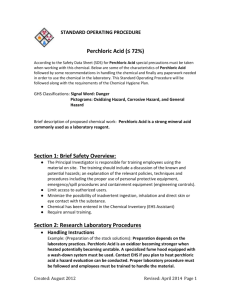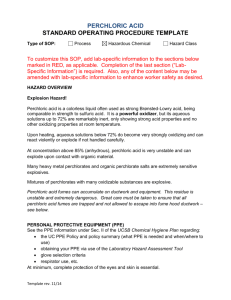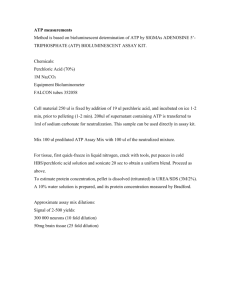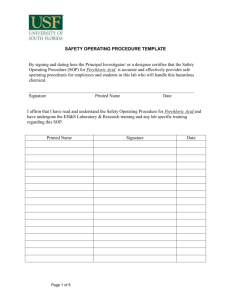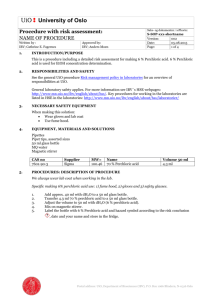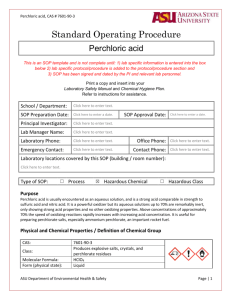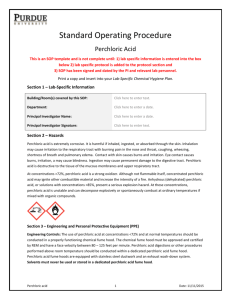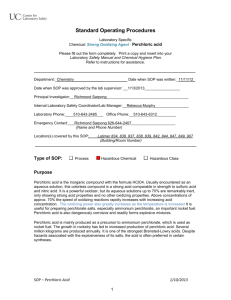Perchloric Acid and Perchlorate Salts SOP Template
advertisement
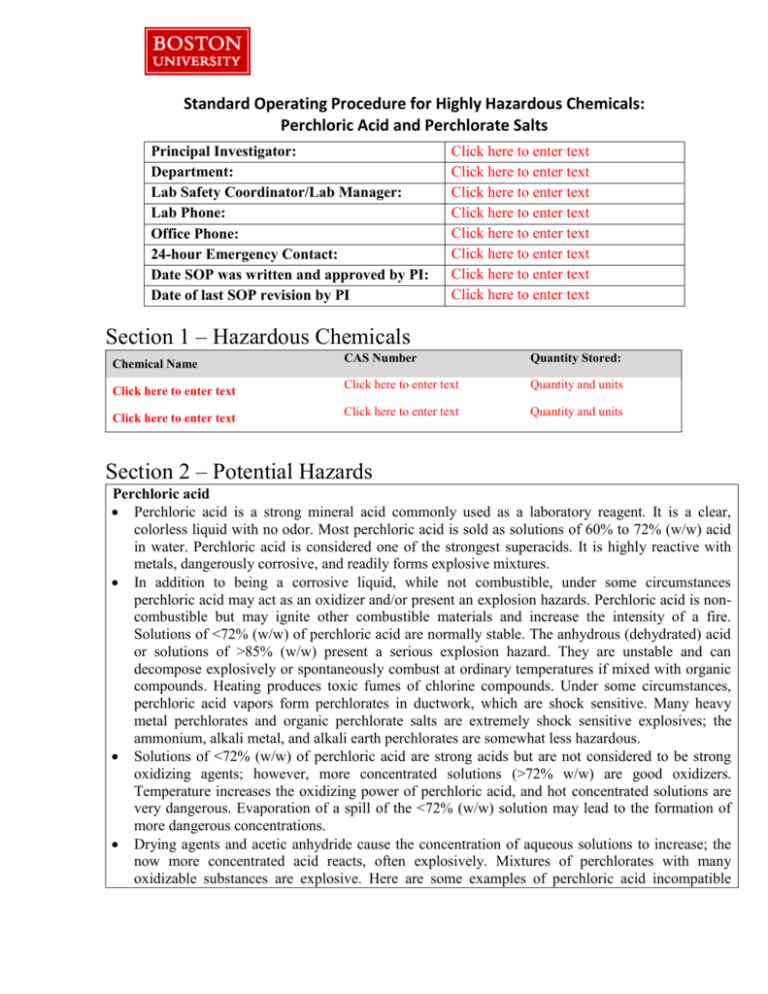
Standard Operating Procedure for Highly Hazardous Chemicals: Perchloric Acid and Perchlorate Salts Principal Investigator: Department: Lab Safety Coordinator/Lab Manager: Lab Phone: Office Phone: 24-hour Emergency Contact: Date SOP was written and approved by PI: Date of last SOP revision by PI Click here to enter text Click here to enter text Click here to enter text Click here to enter text Click here to enter text Click here to enter text Click here to enter text Click here to enter text Section 1 – Hazardous Chemicals Chemical Name Click here to enter text Click here to enter text CAS Number Quantity Stored: Click here to enter text Quantity and units Click here to enter text Quantity and units Section 2 – Potential Hazards Perchloric acid Perchloric acid is a strong mineral acid commonly used as a laboratory reagent. It is a clear, colorless liquid with no odor. Most perchloric acid is sold as solutions of 60% to 72% (w/w) acid in water. Perchloric acid is considered one of the strongest superacids. It is highly reactive with metals, dangerously corrosive, and readily forms explosive mixtures. In addition to being a corrosive liquid, while not combustible, under some circumstances perchloric acid may act as an oxidizer and/or present an explosion hazards. Perchloric acid is noncombustible but may ignite other combustible materials and increase the intensity of a fire. Solutions of <72% (w/w) of perchloric acid are normally stable. The anhydrous (dehydrated) acid or solutions of >85% (w/w) present a serious explosion hazard. They are unstable and can decompose explosively or spontaneously combust at ordinary temperatures if mixed with organic compounds. Heating produces toxic fumes of chlorine compounds. Under some circumstances, perchloric acid vapors form perchlorates in ductwork, which are shock sensitive. Many heavy metal perchlorates and organic perchlorate salts are extremely shock sensitive explosives; the ammonium, alkali metal, and alkali earth perchlorates are somewhat less hazardous. Solutions of <72% (w/w) of perchloric acid are strong acids but are not considered to be strong oxidizing agents; however, more concentrated solutions (>72% w/w) are good oxidizers. Temperature increases the oxidizing power of perchloric acid, and hot concentrated solutions are very dangerous. Evaporation of a spill of the <72% (w/w) solution may lead to the formation of more dangerous concentrations. Drying agents and acetic anhydride cause the concentration of aqueous solutions to increase; the now more concentrated acid reacts, often explosively. Mixtures of perchlorates with many oxidizable substances are explosive. Here are some examples of perchloric acid incompatible mixtures: o Nitric acid and cellulose material - explosive o Hydroxyl compounds - explosive o Dimethyl sulphoxide - explosive o Ketones and glycols - violent reactions o Ferrous sulphate - explosive o Reducing agents - explosive Reaction of 70% perchloric acid with cellulose materials such as wood, paper, and cotton can produce fires and explosions. Oxidizable organic compounds including alcohols, ketones, aldehydes, ethers, and dialkyl sulfoxides can react violently with concentrated perchloric acid. All perchlorates are potentially hazardous when in contact with reducing agents. At room temperature, perchloric acid up to concentrations of 72% has properties similar to other strong mineral acids. The acute toxicity of perchloric acid is moderate to high. It is a highly corrosive substance and causes severe burns on contact with the eyes, skin, and mucous membranes. Liquid or spray mist may produce tissue damage on mucous membranes of the eyes. Inflammation of the eye is characterized by redness, watering, itching and blurred vision. It can also lead to loss of vision or blindness. Skin contact may produce inflammation characterized by itching, reddening and blistering. Inhalation of spray or mist may produce severe respiratory tract irritation, causing sore throat, coughing, labored breathing and even lung edema. Ingestion of perchloric acid will cause mouth, throat, stomach and intestinal tract burns, along with abdominal pain and diarrhea. Perchlorate salts Perchlorate salts are a class of potentially explosive chemicals that contain the perchlorate anion (ClO4-). These chemicals can release a destructive amount of pressure, gas, or heat when subjected to certain conditions such as high temperatures or sources of ignition. These compounds also tend to be strong oxidizers. Contact with other material may cause and/or intensify fires. Some perchlorate compounds are potentially explosive when subjected to certain conditions. Perchlorate salts may be harmful if ingested, inhaled, or absorbed through the skin. These compounds may cause irritation to the gastrointestinal tract, respiratory tract, skin, and eyes. Some perchlorate salts are mass explosion hazards. Additionally, upon combustion it forms hazardous products such as nitrogen oxides and hydrogen chloride gas. Examples of perchlorate salts include: o organic perchlorate salts o ammonium, alkali metal, and alkali earth perchlorates o transition metal perchlorates Perchlorate salts are used in pyrotechnics and in treating thyroid disorders such as hyperthyroidism. Here are some common perchlorate salts used in laboratories: o Ammonium perchlorate is predominantly used in pyrotechnics, explosives and solid fuel for rockets. Laboratory use includes analytical techniques and etching/engraving. o Calcium perchlorate is a reduced moisture salt used in organic synthetic reactions. o Ferric perchlorate hydrate has many uses including an oxidant for conducting polymer nanoparticles synthesized in ionic liquid by chemical polymerization. o Lithium perchlorate is mainly used as a source of electrolytes in electrochemical measurements and in lithium batteries. It can also be used as a source of oxygen in chemical oxygen generators. o Manganese perchlorate hexahydrate can be used as starting material for homometallic, o o o o trinuclear heteroscorpionate complexes used to study electronic and magnetic properties Silver perchlorate is a useful source of the Ag+ ion, however its use has declined in chemical synthesis from concerns of perchlorate salts explosive properties. Sodium perchlorate is used as a non-reactive electrolyte, commonly used in DNA extraction and hybridization reactions. Tetrabutylammonium perchlorate (TBAP) is mainly used as a source of electrolytes in electrochemical measurements. Zinc perchlorate hexahydrate is mainly used in chemical syntheses. It is a highly efficient catalyst in the opening of epoxides by amines. It may also be used as an oxidizing agent in explosives. Section 3 – Trainings/Approvals Required PI or designee must provide training to the laboratory personnel specific to the hazards involved in working with hazardous chemicals, work area decontamination, and emergency procedures. The laboratory personnel should attend the trainings, review this SOP and SDS and complete the documentation of training. The trainings should be provided prior to work with hazardous chemicals and annual refresher thereafter. PI or designee should inform EHS for using perchloric acid above room temperature. EHS will evaluate the operating procedures and advise on the handling requirements. Section 4 – Designated Area Storage & Use Location: Enter Building and Room Number(s) Enter Storage Conditions. (For example: room temperature, refrigerator, inert atmosphere, glove Storage Conditions: box. Please refer to Section 7 for more information on choosing appropriate storage conditions) Section 5 – Engineering Controls / Emergency Safety Equipment Engineering Controls All handling and use of perchloric acid and perchlorate salts must be performed inside a certified chemical fume hood and with the sash at the lowest possible height for safe usage of reagents. Works involving heating of perchloric acid <72% and anhydrous perchloric acid (>85%) should be done in a dedicated perchloric acid fume hood with a wash down system. Emergency Safety Equipment An eyewash, safety shower, and ABC fire extinguisher must be available within the work area for immediate emergency use. All personnel must be aware of their locations prior to working with highly hazardous chemicals. Section 6 – Personal Protective Equipment Eye Protection Fully enclosed goggles or a face shield are recommended for work with these chemicals as they offer greater facial protection than safety glasses. Hand Protection Gloves must be worn when handling perchloric acid and perchlorate salts. Disposable nitrile gloves should be adequate for handling most of these in general laboratory settings. Recommended gloves materials for perchloric acid concentrations of 30-70%: butyl rubber, natural rubber, neoprene rubber, nitrile rubber, polyvinyl chloride, Tychem ® BR/LV, Responder ® and TK. If direct or prolonged contact is anticipated, appropriate chemical-resistant gloves should be used. A Safety Data Sheet (SDS) should be reviewed if handling may involve extended or high exposure to lab personnel to ensure adequate skin protection is provided. Skin and Body Protection Protection equipment against chemicals such as lab coats is required. Full-length pants or equivalent as well as closed toe shoes must be worn. Long-sleeved clothing, lab coat or apron is advised if more than normal handling operations could be expected. Design experiment so that the work can be performed in a hood behind a safety blast shield to protect against possible explosions. Section 7 – Special Handling Procedures and Storage Requirements Precautions for safe handling Do not work alone when working with highly hazardous chemicals. All colleagues in the area should be made aware of the hazards with the project. Inform others in the laboratory about your usage of highly hazardous chemicals. Do not allow further concentrate by the evaporation of the water. If at all possible, utilize another reagent to serve as a counter ion, as perchlorate salts of transition metal complexes are known to be shock sensitive and can easily detonate upon manipulation or collection of the solid product. Design experiment so that the work can be performed behind a safety shield if at all possible. Prevent contact with organic materials. Contact with combustible or flammable materials can cause fire or explosion. This material promotes combustion. It can react violently or explosively with many organic and inorganic chemicals. Oxidizing power increases with concentration as well as temperature of solution. Keep the material cool. Any use of this material in an elevated temperature process must be thoroughly evaluated to determine safe operating conditions. Use hot plates or steam baths to heat solutions rather than open flame heating or oil baths. Use the smallest possible amounts in an area separate from storage area. Avoid generating vapors (if heating) or mists. Prevent the release of vapors and mists into the workplace air. Do not attempt to open a container if it is of unknown age of its physical characteristics differ from the pure substance (such as color change, crystal formation). Discard the material if discoloration occurs. If a bottle containing perchloric acid has crystals forming around the bottom of the bottle, there is a potential explosion hazard. Do not move the bottle. Contact EHS for assistance. Fume hood requirements for perchloric acid Perchloric acid should always be handled in a working fume hood to keep the level of exposure as low as possible. Perchloric acid digestions and other procedures performed above ambient temperatures should be done in a specially designed perchloric acid fume hoods equipped with a wash down system. Solutions of 72% perchloric acid at room temperature have no vapor pressure and therefore no vapor should get into the hood. Lab work that is done in room temperature does not require special perchlorate fume hoods. However, work involving anhydrous perchloric acid (>85%) should always be done in a dedicated perchloric acid fume hood. Dedicated perchloric acid fume hood and ducts are made of stainless steel. An exhaust air scrubber system is present in the ductwork and behind the baffle to emit a fine water spray to dilute and wash down the acid fumes and vapours when the fume hood is in use. Solvents must never be used or stored in a designated perchloric acid fume hood. For < 72% Perchloric Acid at Room Temperature At room temperature, perchloric acid up to concentrations of 72% has properties similar to other strong mineral acids. When used under these conditions, perchloric acid reacts as a strong non-oxidizing acid. The following precautions should be taken when using perchloric acid under these conditions: Substitute with less hazardous chemicals when appropriate. Use dilute solutions (<60%) whenever possible. Conduct operations involving cold perchloric acid in a certified chemical fume hood Always transfer perchloric acid over suitable containment in order to catch any spills and afford a ready means of cleanup and disposal. Perform all operations on chemically resistant surfaces. Avoid contact with cellulose materials such as wood, paper and cotton, which could result in a fire or explosion. For < 72% Perchloric Acid Heated Hot, dilute perchloric acid is not an effective oxidizing agent. It begins to exhibit some oxidizing potential at about 50% concentration. Heating the dilute perchloric acid solutions above room temperature will drive off water vapor, thereby increasing the acid concentration. When heated to temperatures above 150 C, perchloric acid becomes a strong oxidizer and eventually becomes unstable and can react violently with many oxidizable substances and detonate. Vapors may also contaminate work surfaces or ventilation equipment with perchlorate residues, which may form highly unstable compounds, such as metallic perchlorates. Perchloric acid digestions and other procedures performed at elevated temperatures should be done in a specially designed perchloric acid fume hoods. Never heat perchloric acid in an oil bath or with an open flame. Electric hot plates, electrically or steam-heated sand baths, heating mantles, or steam baths are preferred. Use explosion proof electrical equipment. Avoid allowing hot perchloric acid to come into contact with any organic materials, including paper or wood, because a fire or explosion can occur. Avoid storing these materials in perchloric acid work hoods. Avoid using greases or hoses that are incompatible with perchloric acid. In wet digestions with perchloric acid, treat the sample first with nitric acid to destroy easily oxidizable matter. Do not distill perchloric acid in a vacuum, because the unstable anhydride may be formed and cause a spontaneous explosion. Wash down perchloric acid hood after each use, following operating instructions provided by the manufacturer of the perchloric acid hood. All apparatus should have glass-to-glass joints. Use silicon-based lubricants for glass-to-glass joints. Do not use rubber stoppers, tubes or stopcocks. If an apparatus cracks or breaks due to thermal or mechanical shock, the hazards are sufficient to make it desirable to consider using quartz apparatus since it is necessary in many experiments to chill perchloric acid rapidly from the boiling point. Post a sign on the hood stating “Perchloric Acid Use Only. Organics Prohibited”. Do not use or store organic solvents in the hood. Dilution of perchloric acid must be done by adding acid to water, not the reverse. Use of perchloric acid hood for other chemistry requires prior total decontamination of the hood. For Anhydrous Perchloric Acid (> 85%) Anhydrous perchloric acid is very unstable and will usually explode when it encounters organic materials. Only experienced research workers should handle anhydrous perchloric acid and follow these additional precautions: Never work alone when handling anhydrous perchloric acid. A second worker has to be informed of the work and should be in sound or sight contact with the worker using anhydrous perchloric acid. Use a safety shield to protect oneself against the effects of a possible explosion. The work has to be done in a designated perchloric acid fume equipped with a wash down system. No extraneous chemicals should be present in the fume hood while performing the work. Longer and thicker gloves (in addition to the recommended PPE) should be worn. Use only freshly prepared acid. Do not make any more anhydrous perchloric acid than is required for a day/shift. Storage requirements Never return excess chemicals to the original container. Purchase only the smallest amounts necessary for your work, and discard old materials promptly. Reagents should be periodically examined to ensure containers are in good condition. Storage requirements will depend on the specific chemical being stored. Check Safety Data Sheets for incompatibilities when storing chemicals. Avoid storing the material by exits. Store in a cool, dry area, out of direct sunlight and away from heat and ignition sources. Containers should not be subjected to a temperature higher than 49 C (120 F). Do not allow perchloric acid to come into contact with strong dehydrating agents (concentrated sulfuric acid, anhydrous phosphorus pentoxide, etc). Perchloric acid should be stored in its original container within compatible secondary containment, preferably glass or porcelain. Glass trays should be wiped periodically. Perchloric acid should be separated from other chemicals, but may be stored with other inorganic acids, preferably in a metal cabinet designed for acid/corrosive storage. Perchloric acid must be stored away from organic chemicals, flammable or combustible materials and strong dehydrating agents such as sulfuric acid and anhydrous phosphorus pentoxide. Perchloric acid is incompatible with the following chemicals and must not be stored with them because of the danger of explosion or fire: Acetic acid Glycol ethers Acetic anhydride Hydriodic acid Alcohols Hydrochloric acid Aniline Hypophosphites Antimony compounds (trivalent) Ketones Bismuth Dehydrating agents Diethyl ether Formaldehyde mixtures Fluorine Glycerine Glycols Lead oxide mixtures Nitrogen triiodide Nitrosophenol Organic matter (e.g. paper, wood, charcoal, rags, cotton, etc.) Sodium iodide Sulfoxides and Sulfur trioxide Transport requirements Transportation of hazardous chemicals should follow the guidelines for chemicals as described in the BU Chemical Hygiene Plan. For bulk transport, chemicals should be transported using a clean cart. The materials themselves must be in sealed containers, clearly labeled with the contents name and applicable hazard classification(s). Section 8 – Spill and Accident Procedures Emergency procedures for chemical exposure Remove any contaminated clothing as quickly as possible. Flush any exposed skin or hair with water for at least 15 minutes. Do not hesitate in activating a safety shower. For chemical exposure to the eye, flush with water for at least 15 minutes at an emergency eyewash station. Hold eyelids open while flushing. Seek appropriate medical assistance. If transported to hospital, bring a Safety Data Sheet (SDS) for the material you were exposed to, if able. Emergency procedures for chemical spill or accident Remove personnel from the immediate area. If the spill is small, dilute the perchloric acid with water and clean. Do not attempt to handle a large spill/reaction/fire, or one in which you are not trained or equipped for. Turn off all ignition sources if this can be done safely, vacate the area, and call for assistance. Follow the reporting procedures on the Emergency Flip Chart. Section 9 – Waste Disposal Perchlorate contamination test Surfaces can also be tested to check for perchlorate contaminations: Diphenylamine Test: Dissolve one gram of diphenylamine in 10 mL of “1 to 1” (18N) sulfuric acid to form a diphenylamine sulfate solution. Using a medicine dropper, apply this solution to the test surface. The liquid turns black upon contact with perchlorate. The solution also reacts with nitrates, but turns blue. Methylene Blue Test: Use 0.4% solution of methylene blue in water. Add a few drops of indicator solution to about 25 mL of trial solution, such as water used to test rinse from a length of potentially contaminated duct. Perchlorates will produce a violet precipitate. Waste disposal Perchloric acid waste should never be mixed with other organic wastes. It should be kept in clearly identified containers labelled “Perchloric Acid Waste”. If a bottle containing perchloric acid has turned dark and has crystals forming around the bottom of the bottle, there is a potential explosion hazard. Do not touch the container, as it might be highly unstable and shock sensitive. Any attempts to move or open the container might result into an explosion. Visually inspect the container in order to identify the content and to look for an expiration date. All waste and contaminated disposables should be disposed of as hazardous waste, including labeling as hazardous waste and use of secondary containment. Waste disposal requests should be directed to EHS at http://www.bu.edu/ehs/services/waste/chemical-waste/. Section 10 – Lab Specific Changes Laboratory-Specific Procedures: Describe any deviation from the recommended practices in the SOP Documentation of Training Print this page (multiple copies as needed) and insert into your Chemical Safety Logbook, under the Personnel and User Certification section. The laboratory personnel should attend annual training sessions, review this SOP and SDS, and sign the training form. Signature of all users is required. I have read and understand the content of the referenced SOP: Name (please print) Signature Date
